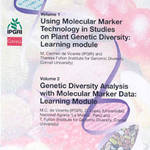Molecular Marker Learning Modules: Volumes 1 and 2
 |
These modules aim to promote capacity building and research biodiversity use and conservation worldwide through the application of molecular markers.
They are especially directed to those countries with limited access to up-to-date scientific literature and research technologies. They discuss the fundamental principles of genetic diversity, the qualities of the markers used to measure it and the most widely used technologies, including those based on proteins, DNA and the polymerase chain reaction.
The modules are intended for scientists with a minimal background in genetics and plant molecular biology, but with a working knowledge of plant genetic resources and issues concerning their conservation and management.
Volume 1: Using Molecular Marker Technology in Studies on Plant Genetic Diversity: Learning module M. Carmen de Vicente (IPGRI) and Theresa Fulton (Institute for Genomic Diversity, Cornell University)
Title page (PDF 115 KB)
Preface (PDF 9 KB)
Foreword (PDF 11 KB)
About this module (PDF 13 KB)
Objectives (PDF 7 KB)
I. Introduction (PDF 486 KB)
II. Protein-based technologies
Protein basics (PDF 137 KB)
Isozymes (PDF 295 KB)
III. DNA-based technologies
DNA basics (PDF 394 KB)
Restriction fragment length polymorphisms (RFLPs) (PDF 503 KB)
PCR basics (PDF 326 KB)
PCR with arbitrary primers (PDF 206 KB)
Amplified fragment length polymorphisms (AFLPs) (PDF 279 KB)
Sequence-tagged sites (Microsatellites etc) (PDF 308 KB)
Latest strategies (PDF 324 KB)
IV. Complementary technologies (PDF 136 KB)
Denaturing gradient gel electrophoresis (DGGE)
Thermal gradient gel electrophoresis (TGGE)
Single-stranded conformational polymorphism (SSCP)
Heteroduplex analysis
Denaturing high-performance liquid chromatography (DHPLC)
V. Final considerations (PDF 152 KB)
Considerations when choosing a technique
Practical applications
Glossary (PDF 33 KB)
Feedback form (PDF 14 KB)
Acknowledgements (PDF 11 KB)
Copyright (PDF 50 KB)
Volume 2: Genetic Diversity Analysis with Molecular Marker Data: Learning Module M.C. de Vicente (IPGRI), C. Lopez (Universidad Nacional Agraria 'La Molina', Peru) and T. Fulton (Institute for Genomic Diversity, Cornell University)
Title page (PDF 80 KB)
Foreword (PDF 27 KB)
About this module (PDF 75 KB)
Objectives (PDF 60 KB)
I. Introduction (PDF 519 KB)
II. Basic concepts of population genetics (PDF 630 KB)
III. Measures of genetic diversity (PDF 342 KB)
IV. Software programs for analysing genetic diversity (PDF193 KB)
V. Glossary (PDF 80 KB)
VI. Feedback form (PDF 47 KB)
VII. Acknowledgements (PDF 30 KB)
VIII. Copyright (PDF 71 KB)
IX. Appendixes
Appendix 1: Basic Concepts of Population Genetics: Critical values of the chi-square distribution (PDF 37 KB)
Measures of Genetic Diversity
Appendix 2: Analysis of molecular variance: Example 1 (PDF 40 KB)
Appendix 3: Analysis of molecular variance: Example 2 (PDF 40 KB)
Appendix 4: Geometric distance (PDF 50 KB)
Appendix 5: Transforming data from quantitative variables: An example (PDF 53 KB)
Appendix 6: Applying the simple matching coefficient for morphological characters (categorical variables) (PDF 54 KB)
Appendix 7: Calculating Nei’s genetic distance (PDF 58 KB)
Appendix 8: Morphological and molecular similarities (PDF 176 KB)
Appendix 9: Software Programs for Analysing Genetic Diversity (PDF 31 KB)
Comments
- No comments found





Leave your comments
Post comment as a guest